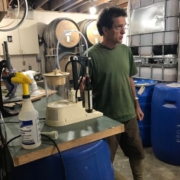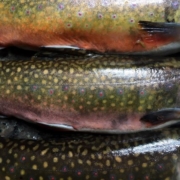Side Hill Cider Mill
Apple Balsamic Vinegar of Vermont hit the shelves just last fall. Made by Side Hill Cider Mill in Vershire, it’s a highly unusual product. Neil Hochstedler, the owner, has found only two other producers – one in Ireland and a small company in Massachusetts. He said his idea “seemed like a natural and logical” extension of his existing cider vinegar business.
Neil’s been deep into apples since the 1970s, when he picked and pruned for a living. He brought his work home with him, grafting and pruning apples at his own place. Before long, he was producing more perishable apple juice than he could use, and he turned some into cider vinegar, which he has been selling for several years. Too much vinegar inspired him to diversify his offerings, so he created a balsamic line. With help from Sebastian and Sabra Ewing of neighboring Flag Hill Farm, they pretty much invented a commercial-scale production process and have gotten started on marketing.
Not unlike the more familiar balsamic vinegar made from red grapes, Neil’s process begins with boiling apple juice to a sweet syrup, which is done in a small sugaring evaporator.
To make cider vinegar, the sugars in apple juice are first fermented to alcohol and, in a second fermentation step, acetic acid-forming bacteria that have survived the fermentation process are augmented with selected acetobacters which convert the alcohol to vinegar.
To make apple balsamic, the cider vinegar is mixed with the sweet apple syrup until the acid level is right. The mix is then aged in wooden barrels, with some oak chips thrown in. At every step, things can go awry. As Neil says, “There have been a lot of setbacks.” But he finds the complicated relationships among the ingredients and conditions fascinating, and when the right apples, aeration, time, and temperature have been provided, the result makes it worth all the trials and errors.
Neil’s other job is as a machinist, which has come in handy: he’s converted a carpet steamer into a tool that shrinks the sleeves on the bottle caps and has modified aquarium pumps to aerate tanks of vinegar. The kind of electric mats made for starting seeds keep the tanks warm.
The label on the Apple Balsamic Vinegar of Vermont says that it’s “Organic * Gourmet * Handmade * Subtle * Complex,” and where it’s sold, mostly at farm stands and coops at this point, it’s being gobbled up. Somewhat unexpectedly, Neil even likes the sales part, especially when he meets anyone interested in vinegar. It seems to have become an obsession. Now there’s a storehouse of tanks, drums, and casks that should keep him obsessed for a long time.
Trout Fishing in Vermont
Many outdoor pursuits, were they analogized to the written arts, would read like essays or newspaper columns. Trout fishing season on the other hand – all two hundred something days of it – is a full-fledged epic novel.
This pretend book – let’s call it “Trout Fishing in Vermont” – has a sprawling, Russian feel, heavy on symbolism and descriptive elements. The story unfolds somberly, the palette heavy towards blues and grays. There’s condensed breath against steely skies. Tension in roiling, potentially hypothermic whitewater. The landscapes are stark: rivers angry; lakes desolate and sterile seeming. First the lakes look glaucomic, with blue edges and icy pupils. Later they steam like cauldrons and appear hot to the touch.
The action is slow in the early chapters. Stocked rainbows provide simple sport and early-spring camaraderie, but the experience is often blunt. Native trout, which make you work for them, can be sluggish and disinterested at first. In fact, on cold years like this one, the book starts off at a glacial pace. But don’t worry. Stick with it, and “Trout Fishing in Vermont” will prove well worth your time.
When our protagonists do make more than a fleeting appearance, often in May, sometimes as late as June, it’s always breathtaking. Matriculated rainbows shine with sheen. Hook-jawed browns present pupil-sized crimson spots. Brookies – the loveliest of all – feature greenish vermiculations that give way to shades of cadmium yellow and pumpkin orange and salmon pink, vibrant colors that grow in depth through the seasons. Part of the charm is that all these fish are beautiful and shy. They’re also sensitive – especially the brookies. To find them, you have to seek out cold, clear water first.
As the novel progresses, it becomes bright and redemptive. Most of it unfolds at a quiet, arthouse pace. There are lots of wandering subplots. A whole chapter might be devoted to a doe and fawn drinking from a pool, or a river-bottom path that leads to a splatter of chanterelles. There are mid-day naps on shady sandbars, the remnants of a fish lunch nearby.
If this all seems random in my retelling, rest assured that the author somehow makes it work.
The human characters in the book are a ragtag bunch: absent-minded poet types, streamside entomologists, worm-can-toting youngsters with old souls, dandies with $1,000 fly rods, rebels with wild hair and empty wallets, to name a few. But while they come from all walks of life, they’re united in devotion to this one particular family of fish. Why not big cretin bass, or cast and catch panfish? Why not charter-boat blues? Why trout? You may as well be asking why love. Why sing.
Read the book and you’ll understand.

 John Douglas
John Douglas